Comprehensive Nursing Care Assignment: Babies and Toddlers, CHCECE005
VerifiedAdded on 2022/10/10
|11
|2109
|113
Homework Assignment
AI Summary
This nursing assignment delves into the multifaceted aspects of caring for babies and toddlers, addressing key areas such as hygiene, routines, mealtime environments, and the creation of safe and supportive spaces. The assignment covers practical scenarios like adapting nappy-changing experiences, sensitively supporting children during toilet training, and recognizing signs of distress. It also includes a detailed case study of a 1-year-old child, Sara, outlining her daily routines, family practices, and potential areas for improvement in the childcare setting. Furthermore, the assignment analyzes various aspects of care, including promoting safe sleep, providing positive nappy-changing and toileting experiences, creating quality mealtime environments, fostering a healthy and safe supporting environment, developing relationships with babies and toddlers, and building relationships with families. The analysis provides recommendations for improvements in each of these areas, ensuring the child's holistic well-being and development within the childcare setting. The assignment emphasizes the importance of communication with families, adapting care to individual needs, and maintaining a safe and stimulating environment for the children.
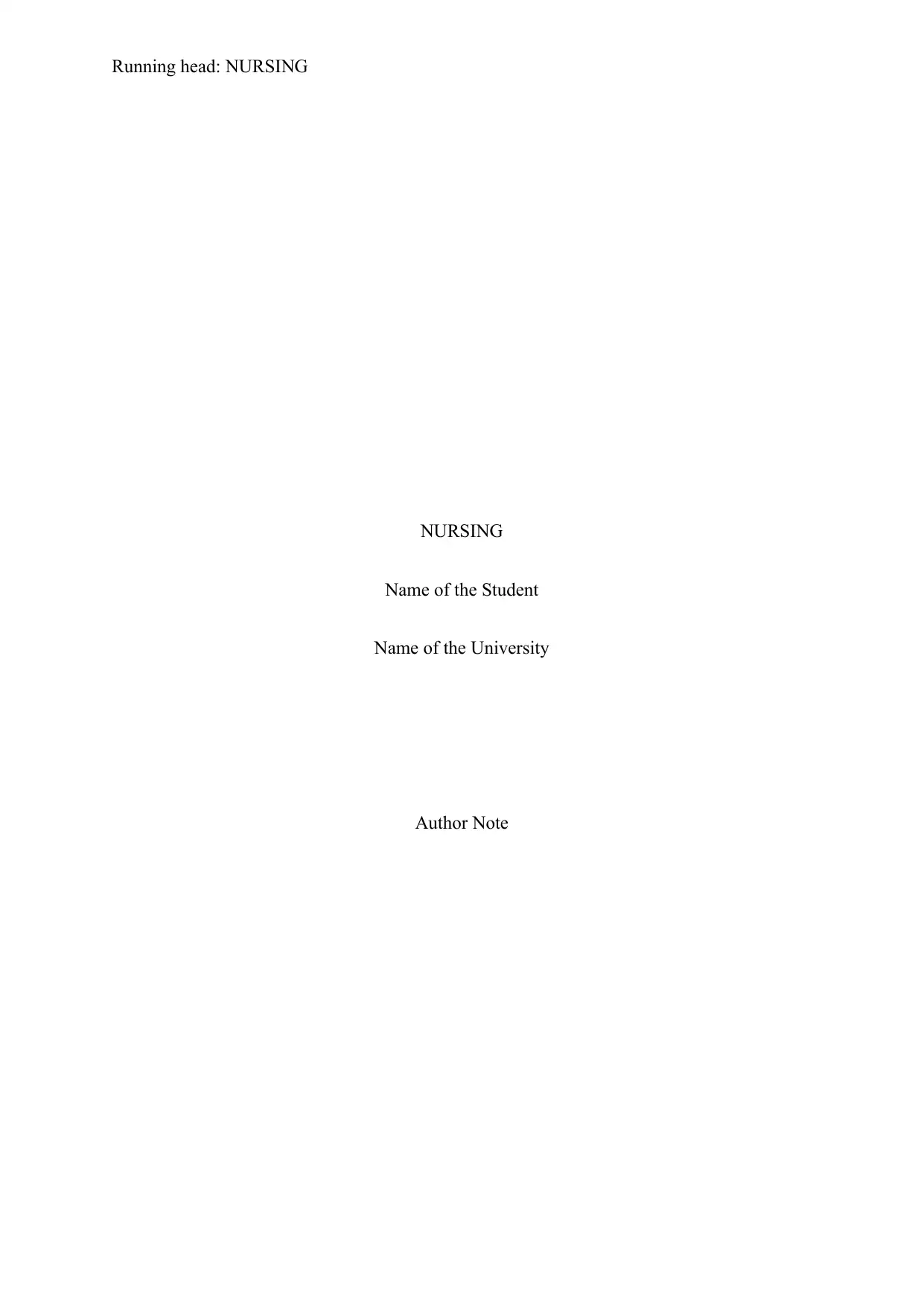
Running head: NURSING
NURSING
Name of the Student
Name of the University
Author Note
NURSING
Name of the Student
Name of the University
Author Note
Paraphrase This Document
Need a fresh take? Get an instant paraphrase of this document with our AI Paraphraser
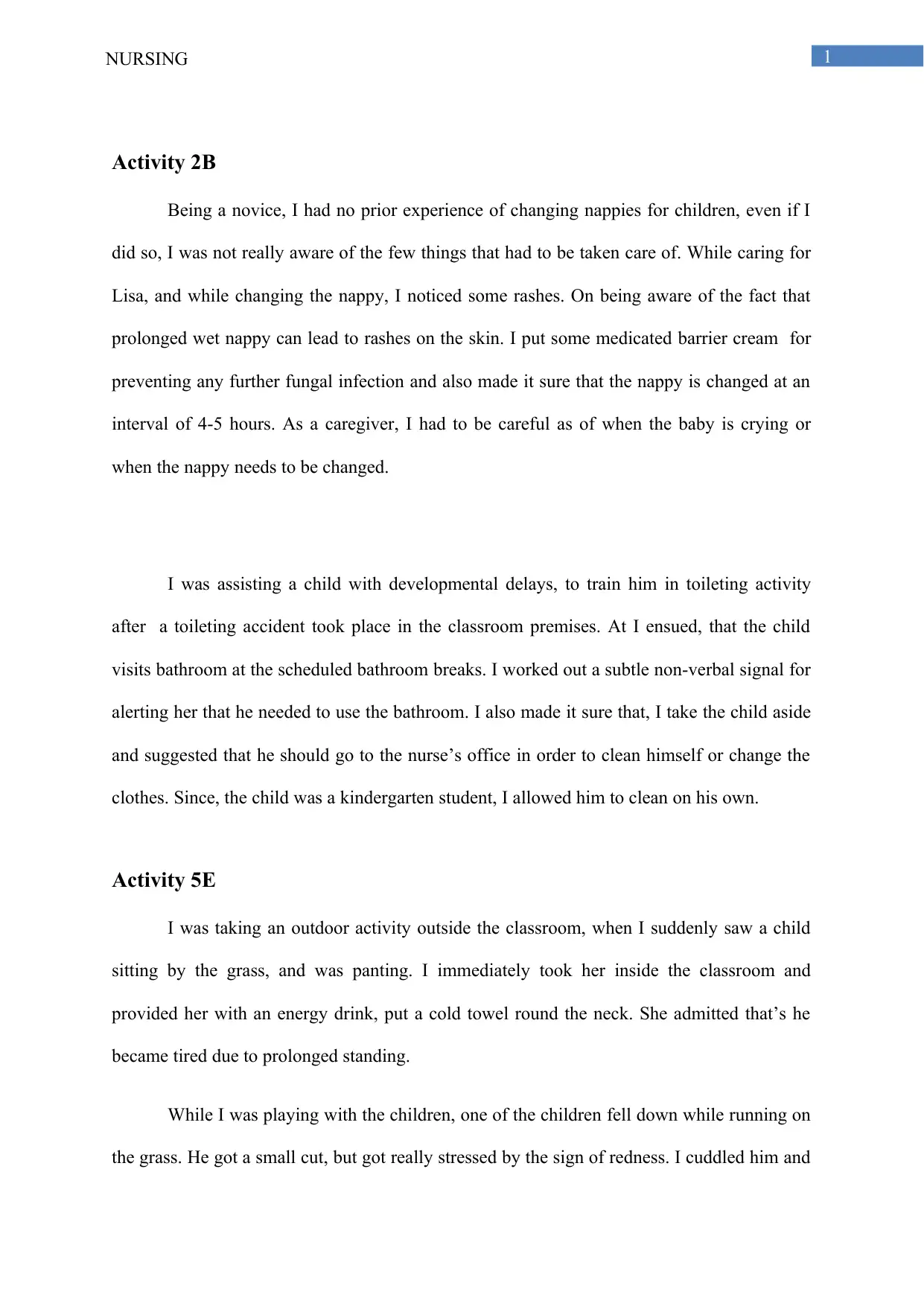
1NURSING
Activity 2B
Being a novice, I had no prior experience of changing nappies for children, even if I
did so, I was not really aware of the few things that had to be taken care of. While caring for
Lisa, and while changing the nappy, I noticed some rashes. On being aware of the fact that
prolonged wet nappy can lead to rashes on the skin. I put some medicated barrier cream for
preventing any further fungal infection and also made it sure that the nappy is changed at an
interval of 4-5 hours. As a caregiver, I had to be careful as of when the baby is crying or
when the nappy needs to be changed.
I was assisting a child with developmental delays, to train him in toileting activity
after a toileting accident took place in the classroom premises. At I ensued, that the child
visits bathroom at the scheduled bathroom breaks. I worked out a subtle non-verbal signal for
alerting her that he needed to use the bathroom. I also made it sure that, I take the child aside
and suggested that he should go to the nurse’s office in order to clean himself or change the
clothes. Since, the child was a kindergarten student, I allowed him to clean on his own.
Activity 5E
I was taking an outdoor activity outside the classroom, when I suddenly saw a child
sitting by the grass, and was panting. I immediately took her inside the classroom and
provided her with an energy drink, put a cold towel round the neck. She admitted that’s he
became tired due to prolonged standing.
While I was playing with the children, one of the children fell down while running on
the grass. He got a small cut, but got really stressed by the sign of redness. I cuddled him and
Activity 2B
Being a novice, I had no prior experience of changing nappies for children, even if I
did so, I was not really aware of the few things that had to be taken care of. While caring for
Lisa, and while changing the nappy, I noticed some rashes. On being aware of the fact that
prolonged wet nappy can lead to rashes on the skin. I put some medicated barrier cream for
preventing any further fungal infection and also made it sure that the nappy is changed at an
interval of 4-5 hours. As a caregiver, I had to be careful as of when the baby is crying or
when the nappy needs to be changed.
I was assisting a child with developmental delays, to train him in toileting activity
after a toileting accident took place in the classroom premises. At I ensued, that the child
visits bathroom at the scheduled bathroom breaks. I worked out a subtle non-verbal signal for
alerting her that he needed to use the bathroom. I also made it sure that, I take the child aside
and suggested that he should go to the nurse’s office in order to clean himself or change the
clothes. Since, the child was a kindergarten student, I allowed him to clean on his own.
Activity 5E
I was taking an outdoor activity outside the classroom, when I suddenly saw a child
sitting by the grass, and was panting. I immediately took her inside the classroom and
provided her with an energy drink, put a cold towel round the neck. She admitted that’s he
became tired due to prolonged standing.
While I was playing with the children, one of the children fell down while running on
the grass. He got a small cut, but got really stressed by the sign of redness. I cuddled him and
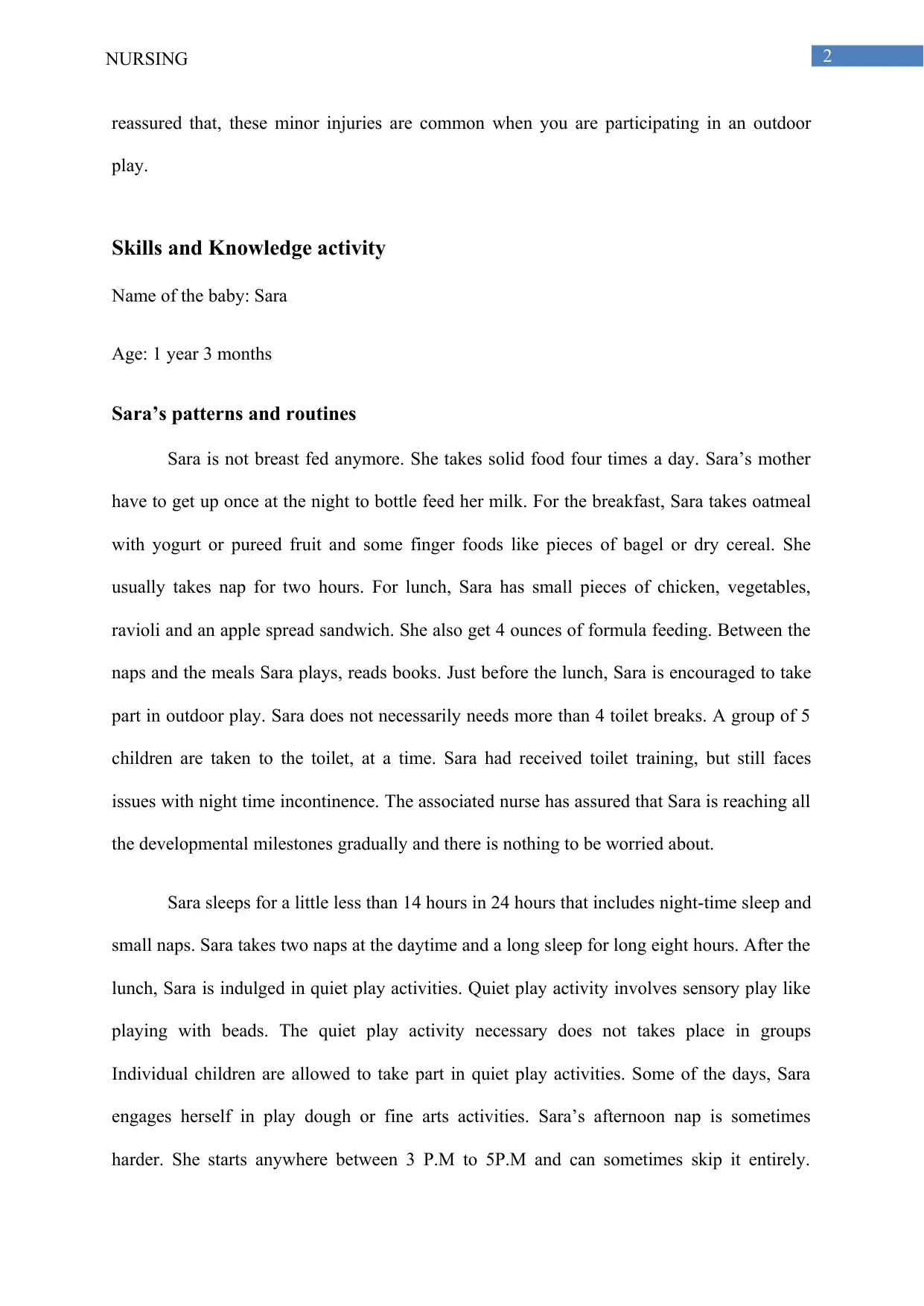
2NURSING
reassured that, these minor injuries are common when you are participating in an outdoor
play.
Skills and Knowledge activity
Name of the baby: Sara
Age: 1 year 3 months
Sara’s patterns and routines
Sara is not breast fed anymore. She takes solid food four times a day. Sara’s mother
have to get up once at the night to bottle feed her milk. For the breakfast, Sara takes oatmeal
with yogurt or pureed fruit and some finger foods like pieces of bagel or dry cereal. She
usually takes nap for two hours. For lunch, Sara has small pieces of chicken, vegetables,
ravioli and an apple spread sandwich. She also get 4 ounces of formula feeding. Between the
naps and the meals Sara plays, reads books. Just before the lunch, Sara is encouraged to take
part in outdoor play. Sara does not necessarily needs more than 4 toilet breaks. A group of 5
children are taken to the toilet, at a time. Sara had received toilet training, but still faces
issues with night time incontinence. The associated nurse has assured that Sara is reaching all
the developmental milestones gradually and there is nothing to be worried about.
Sara sleeps for a little less than 14 hours in 24 hours that includes night-time sleep and
small naps. Sara takes two naps at the daytime and a long sleep for long eight hours. After the
lunch, Sara is indulged in quiet play activities. Quiet play activity involves sensory play like
playing with beads. The quiet play activity necessary does not takes place in groups
Individual children are allowed to take part in quiet play activities. Some of the days, Sara
engages herself in play dough or fine arts activities. Sara’s afternoon nap is sometimes
harder. She starts anywhere between 3 P.M to 5P.M and can sometimes skip it entirely.
reassured that, these minor injuries are common when you are participating in an outdoor
play.
Skills and Knowledge activity
Name of the baby: Sara
Age: 1 year 3 months
Sara’s patterns and routines
Sara is not breast fed anymore. She takes solid food four times a day. Sara’s mother
have to get up once at the night to bottle feed her milk. For the breakfast, Sara takes oatmeal
with yogurt or pureed fruit and some finger foods like pieces of bagel or dry cereal. She
usually takes nap for two hours. For lunch, Sara has small pieces of chicken, vegetables,
ravioli and an apple spread sandwich. She also get 4 ounces of formula feeding. Between the
naps and the meals Sara plays, reads books. Just before the lunch, Sara is encouraged to take
part in outdoor play. Sara does not necessarily needs more than 4 toilet breaks. A group of 5
children are taken to the toilet, at a time. Sara had received toilet training, but still faces
issues with night time incontinence. The associated nurse has assured that Sara is reaching all
the developmental milestones gradually and there is nothing to be worried about.
Sara sleeps for a little less than 14 hours in 24 hours that includes night-time sleep and
small naps. Sara takes two naps at the daytime and a long sleep for long eight hours. After the
lunch, Sara is indulged in quiet play activities. Quiet play activity involves sensory play like
playing with beads. The quiet play activity necessary does not takes place in groups
Individual children are allowed to take part in quiet play activities. Some of the days, Sara
engages herself in play dough or fine arts activities. Sara’s afternoon nap is sometimes
harder. She starts anywhere between 3 P.M to 5P.M and can sometimes skip it entirely.
⊘ This is a preview!⊘
Do you want full access?
Subscribe today to unlock all pages.

Trusted by 1+ million students worldwide
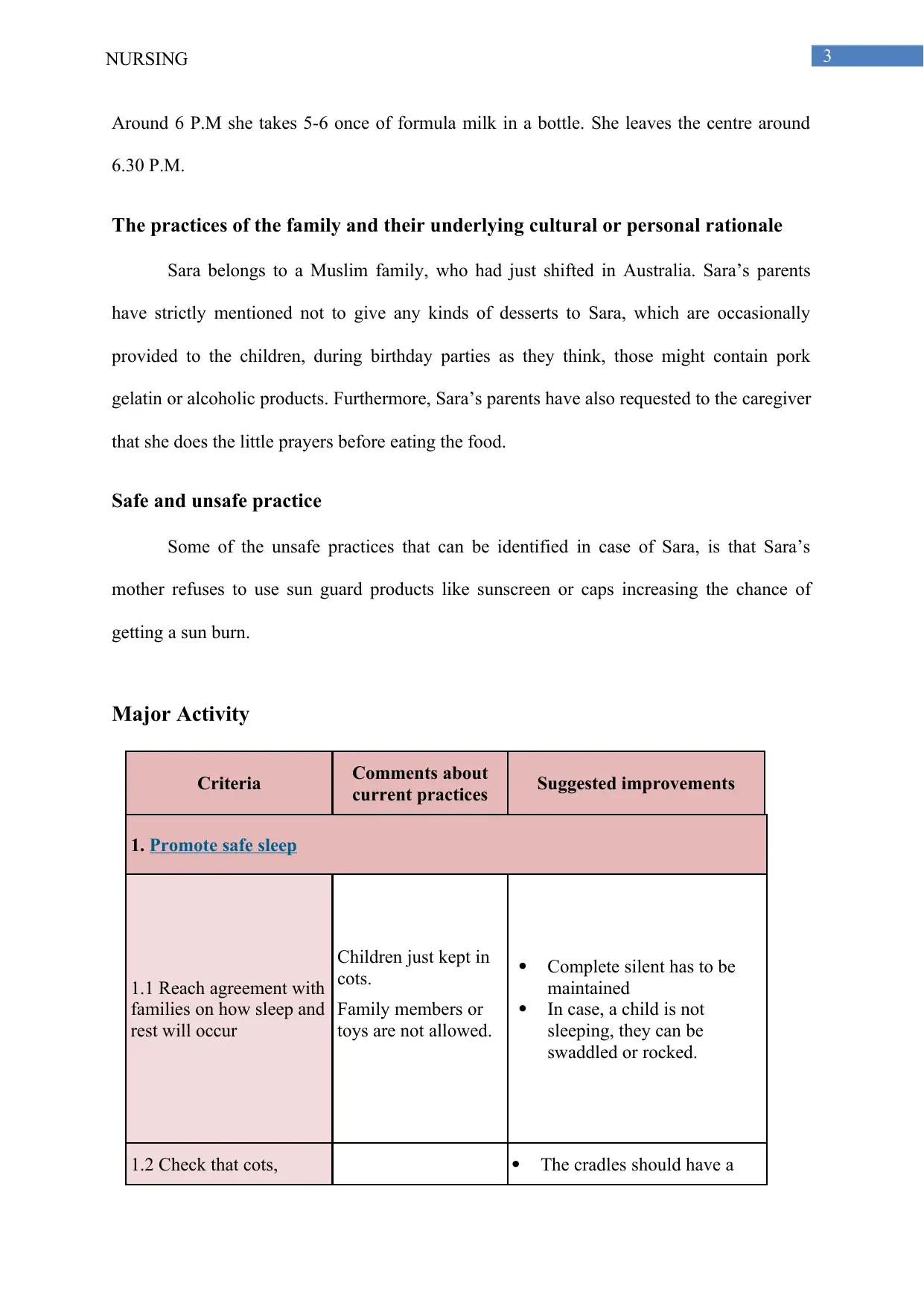
3NURSING
Around 6 P.M she takes 5-6 once of formula milk in a bottle. She leaves the centre around
6.30 P.M.
The practices of the family and their underlying cultural or personal rationale
Sara belongs to a Muslim family, who had just shifted in Australia. Sara’s parents
have strictly mentioned not to give any kinds of desserts to Sara, which are occasionally
provided to the children, during birthday parties as they think, those might contain pork
gelatin or alcoholic products. Furthermore, Sara’s parents have also requested to the caregiver
that she does the little prayers before eating the food.
Safe and unsafe practice
Some of the unsafe practices that can be identified in case of Sara, is that Sara’s
mother refuses to use sun guard products like sunscreen or caps increasing the chance of
getting a sun burn.
Major Activity
Criteria Comments about
current practices Suggested improvements
1. Promote safe sleep
1.1 Reach agreement with
families on how sleep and
rest will occur
Children just kept in
cots.
Family members or
toys are not allowed.
Complete silent has to be
maintained
In case, a child is not
sleeping, they can be
swaddled or rocked.
1.2 Check that cots, The cradles should have a
Around 6 P.M she takes 5-6 once of formula milk in a bottle. She leaves the centre around
6.30 P.M.
The practices of the family and their underlying cultural or personal rationale
Sara belongs to a Muslim family, who had just shifted in Australia. Sara’s parents
have strictly mentioned not to give any kinds of desserts to Sara, which are occasionally
provided to the children, during birthday parties as they think, those might contain pork
gelatin or alcoholic products. Furthermore, Sara’s parents have also requested to the caregiver
that she does the little prayers before eating the food.
Safe and unsafe practice
Some of the unsafe practices that can be identified in case of Sara, is that Sara’s
mother refuses to use sun guard products like sunscreen or caps increasing the chance of
getting a sun burn.
Major Activity
Criteria Comments about
current practices Suggested improvements
1. Promote safe sleep
1.1 Reach agreement with
families on how sleep and
rest will occur
Children just kept in
cots.
Family members or
toys are not allowed.
Complete silent has to be
maintained
In case, a child is not
sleeping, they can be
swaddled or rocked.
1.2 Check that cots, The cradles should have a
Paraphrase This Document
Need a fresh take? Get an instant paraphrase of this document with our AI Paraphraser
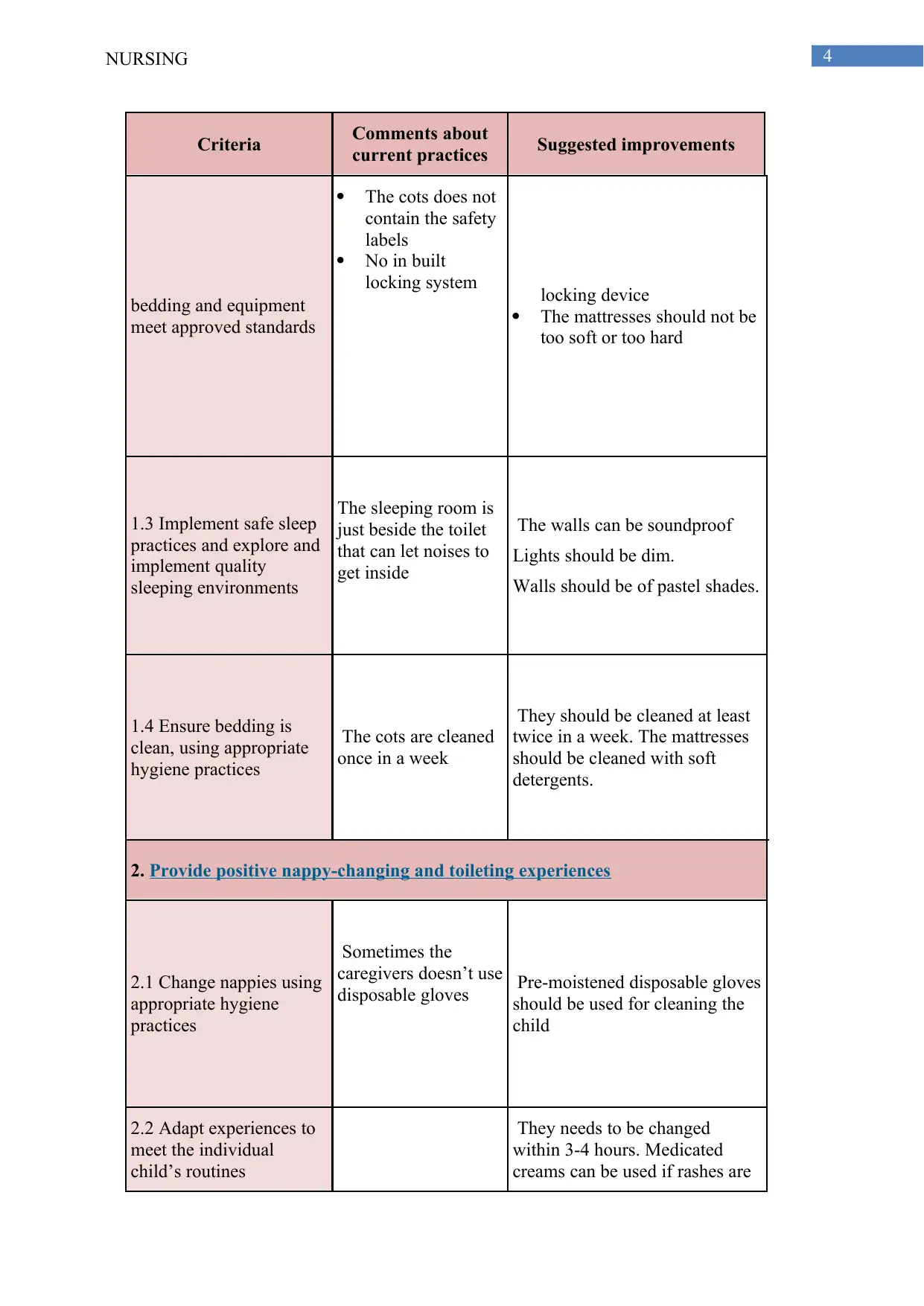
4NURSING
Criteria Comments about
current practices Suggested improvements
bedding and equipment
meet approved standards
The cots does not
contain the safety
labels
No in built
locking system locking device
The mattresses should not be
too soft or too hard
1.3 Implement safe sleep
practices and explore and
implement quality
sleeping environments
The sleeping room is
just beside the toilet
that can let noises to
get inside
The walls can be soundproof
Lights should be dim.
Walls should be of pastel shades.
1.4 Ensure bedding is
clean, using appropriate
hygiene practices
The cots are cleaned
once in a week
They should be cleaned at least
twice in a week. The mattresses
should be cleaned with soft
detergents.
2. Provide positive nappy-changing and toileting experiences
2.1 Change nappies using
appropriate hygiene
practices
Sometimes the
caregivers doesn’t use
disposable gloves Pre-moistened disposable gloves
should be used for cleaning the
child
2.2 Adapt experiences to
meet the individual
child’s routines
They needs to be changed
within 3-4 hours. Medicated
creams can be used if rashes are
Criteria Comments about
current practices Suggested improvements
bedding and equipment
meet approved standards
The cots does not
contain the safety
labels
No in built
locking system locking device
The mattresses should not be
too soft or too hard
1.3 Implement safe sleep
practices and explore and
implement quality
sleeping environments
The sleeping room is
just beside the toilet
that can let noises to
get inside
The walls can be soundproof
Lights should be dim.
Walls should be of pastel shades.
1.4 Ensure bedding is
clean, using appropriate
hygiene practices
The cots are cleaned
once in a week
They should be cleaned at least
twice in a week. The mattresses
should be cleaned with soft
detergents.
2. Provide positive nappy-changing and toileting experiences
2.1 Change nappies using
appropriate hygiene
practices
Sometimes the
caregivers doesn’t use
disposable gloves Pre-moistened disposable gloves
should be used for cleaning the
child
2.2 Adapt experiences to
meet the individual
child’s routines
They needs to be changed
within 3-4 hours. Medicated
creams can be used if rashes are
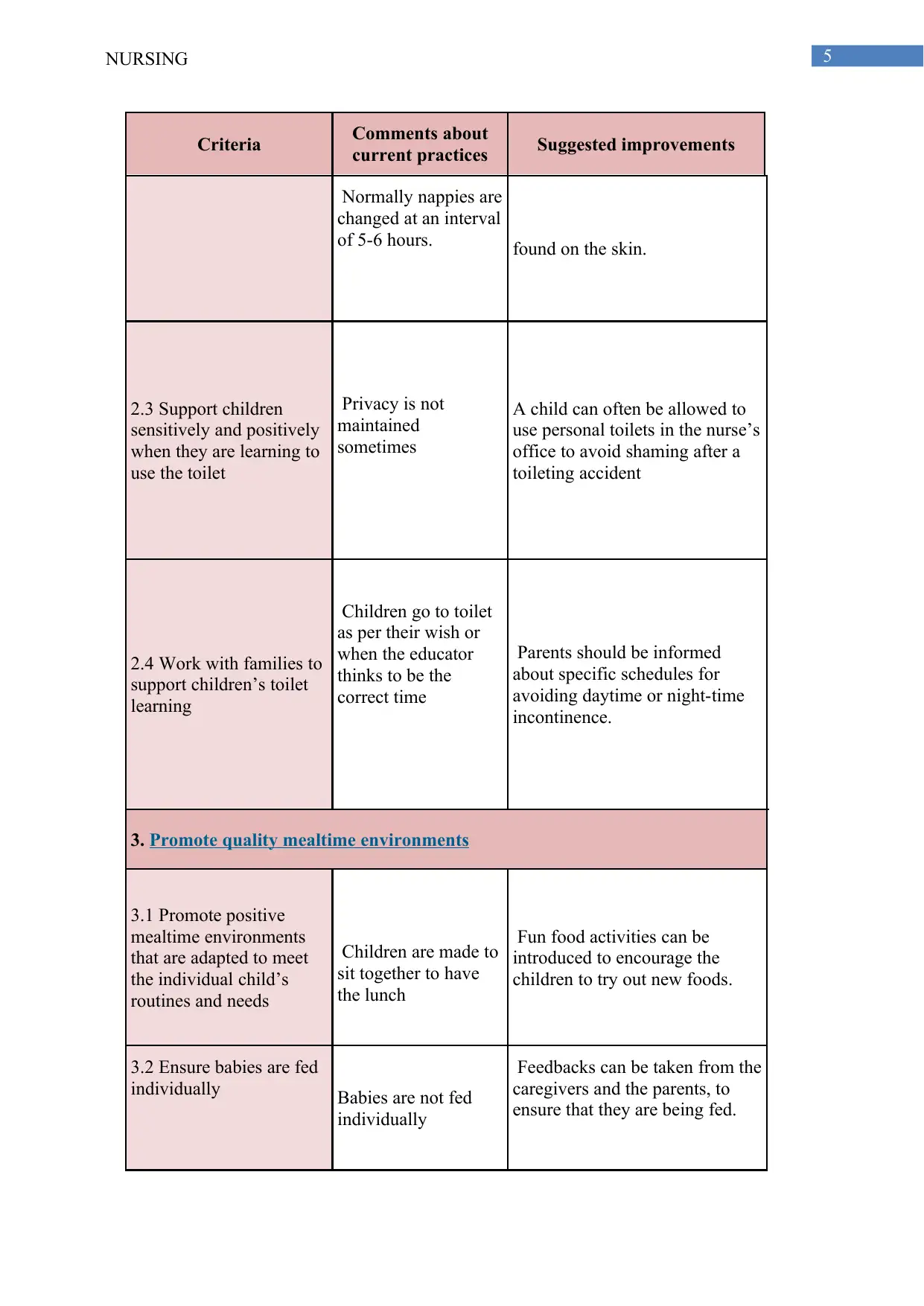
5NURSING
Criteria Comments about
current practices Suggested improvements
Normally nappies are
changed at an interval
of 5-6 hours. found on the skin.
2.3 Support children
sensitively and positively
when they are learning to
use the toilet
Privacy is not
maintained
sometimes
A child can often be allowed to
use personal toilets in the nurse’s
office to avoid shaming after a
toileting accident
2.4 Work with families to
support children’s toilet
learning
Children go to toilet
as per their wish or
when the educator
thinks to be the
correct time
Parents should be informed
about specific schedules for
avoiding daytime or night-time
incontinence.
3. Promote quality mealtime environments
3.1 Promote positive
mealtime environments
that are adapted to meet
the individual child’s
routines and needs
Children are made to
sit together to have
the lunch
Fun food activities can be
introduced to encourage the
children to try out new foods.
3.2 Ensure babies are fed
individually Babies are not fed
individually
Feedbacks can be taken from the
caregivers and the parents, to
ensure that they are being fed.
Criteria Comments about
current practices Suggested improvements
Normally nappies are
changed at an interval
of 5-6 hours. found on the skin.
2.3 Support children
sensitively and positively
when they are learning to
use the toilet
Privacy is not
maintained
sometimes
A child can often be allowed to
use personal toilets in the nurse’s
office to avoid shaming after a
toileting accident
2.4 Work with families to
support children’s toilet
learning
Children go to toilet
as per their wish or
when the educator
thinks to be the
correct time
Parents should be informed
about specific schedules for
avoiding daytime or night-time
incontinence.
3. Promote quality mealtime environments
3.1 Promote positive
mealtime environments
that are adapted to meet
the individual child’s
routines and needs
Children are made to
sit together to have
the lunch
Fun food activities can be
introduced to encourage the
children to try out new foods.
3.2 Ensure babies are fed
individually Babies are not fed
individually
Feedbacks can be taken from the
caregivers and the parents, to
ensure that they are being fed.
⊘ This is a preview!⊘
Do you want full access?
Subscribe today to unlock all pages.

Trusted by 1+ million students worldwide
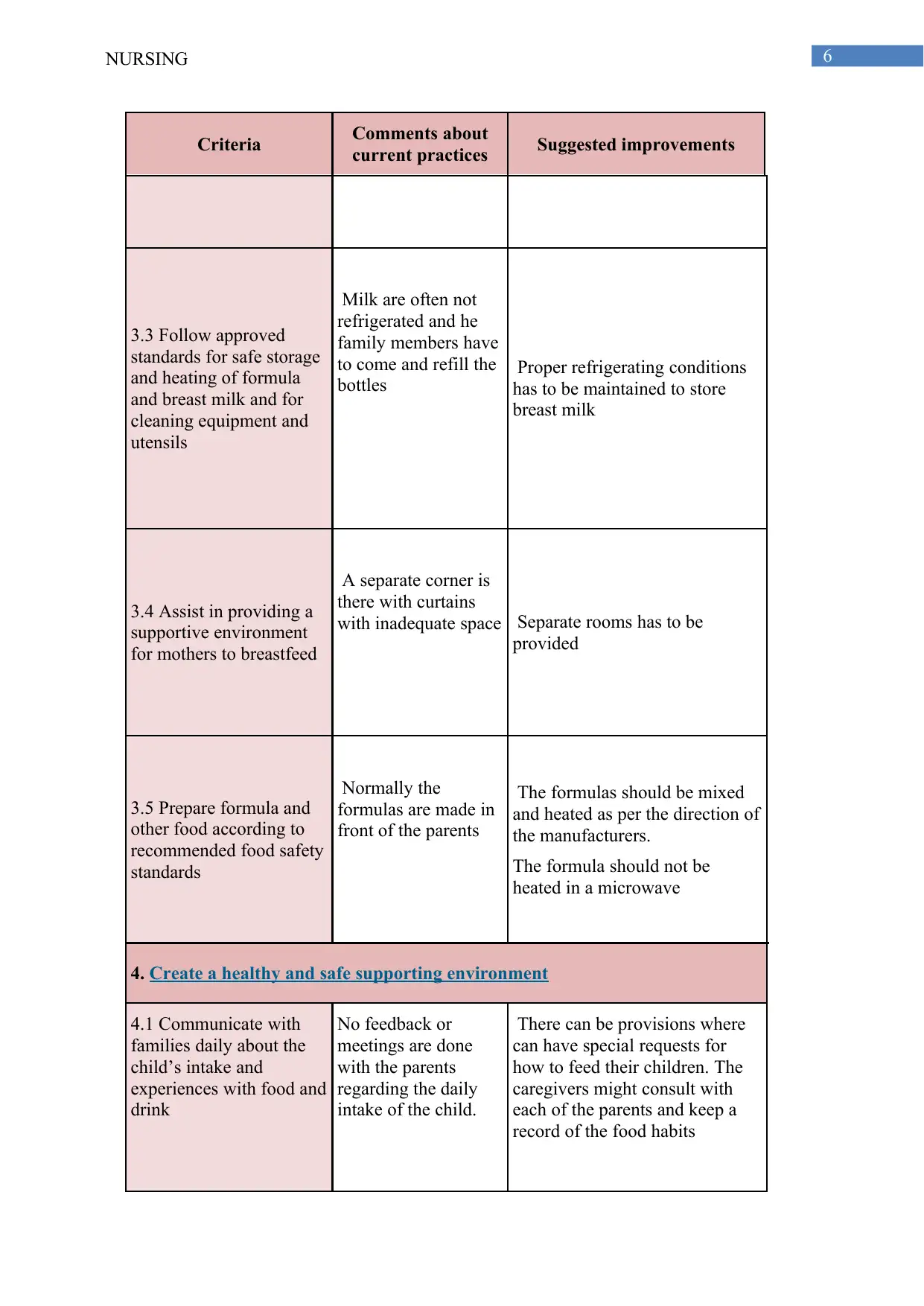
6NURSING
Criteria Comments about
current practices Suggested improvements
3.3 Follow approved
standards for safe storage
and heating of formula
and breast milk and for
cleaning equipment and
utensils
Milk are often not
refrigerated and he
family members have
to come and refill the
bottles Proper refrigerating conditions
has to be maintained to store
breast milk
3.4 Assist in providing a
supportive environment
for mothers to breastfeed
A separate corner is
there with curtains
with inadequate space Separate rooms has to be
provided
3.5 Prepare formula and
other food according to
recommended food safety
standards
Normally the
formulas are made in
front of the parents
The formulas should be mixed
and heated as per the direction of
the manufacturers.
The formula should not be
heated in a microwave
4. Create a healthy and safe supporting environment
4.1 Communicate with
families daily about the
child’s intake and
experiences with food and
drink
No feedback or
meetings are done
with the parents
regarding the daily
intake of the child.
There can be provisions where
can have special requests for
how to feed their children. The
caregivers might consult with
each of the parents and keep a
record of the food habits
Criteria Comments about
current practices Suggested improvements
3.3 Follow approved
standards for safe storage
and heating of formula
and breast milk and for
cleaning equipment and
utensils
Milk are often not
refrigerated and he
family members have
to come and refill the
bottles Proper refrigerating conditions
has to be maintained to store
breast milk
3.4 Assist in providing a
supportive environment
for mothers to breastfeed
A separate corner is
there with curtains
with inadequate space Separate rooms has to be
provided
3.5 Prepare formula and
other food according to
recommended food safety
standards
Normally the
formulas are made in
front of the parents
The formulas should be mixed
and heated as per the direction of
the manufacturers.
The formula should not be
heated in a microwave
4. Create a healthy and safe supporting environment
4.1 Communicate with
families daily about the
child’s intake and
experiences with food and
drink
No feedback or
meetings are done
with the parents
regarding the daily
intake of the child.
There can be provisions where
can have special requests for
how to feed their children. The
caregivers might consult with
each of the parents and keep a
record of the food habits
Paraphrase This Document
Need a fresh take? Get an instant paraphrase of this document with our AI Paraphraser
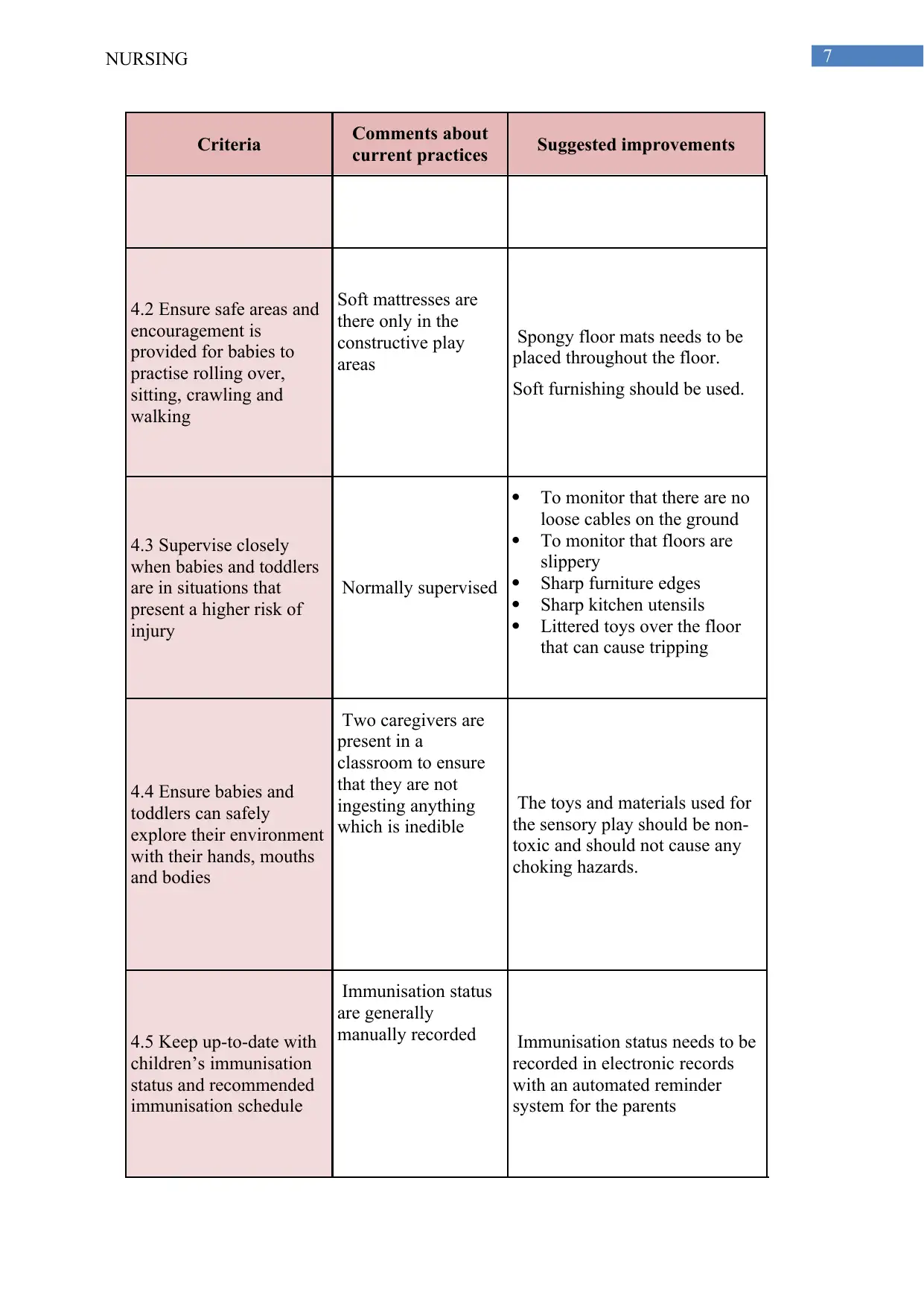
7NURSING
Criteria Comments about
current practices Suggested improvements
4.2 Ensure safe areas and
encouragement is
provided for babies to
practise rolling over,
sitting, crawling and
walking
Soft mattresses are
there only in the
constructive play
areas
Spongy floor mats needs to be
placed throughout the floor.
Soft furnishing should be used.
4.3 Supervise closely
when babies and toddlers
are in situations that
present a higher risk of
injury
Normally supervised
To monitor that there are no
loose cables on the ground
To monitor that floors are
slippery
Sharp furniture edges
Sharp kitchen utensils
Littered toys over the floor
that can cause tripping
4.4 Ensure babies and
toddlers can safely
explore their environment
with their hands, mouths
and bodies
Two caregivers are
present in a
classroom to ensure
that they are not
ingesting anything
which is inedible
The toys and materials used for
the sensory play should be non-
toxic and should not cause any
choking hazards.
4.5 Keep up-to-date with
children’s immunisation
status and recommended
immunisation schedule
Immunisation status
are generally
manually recorded Immunisation status needs to be
recorded in electronic records
with an automated reminder
system for the parents
Criteria Comments about
current practices Suggested improvements
4.2 Ensure safe areas and
encouragement is
provided for babies to
practise rolling over,
sitting, crawling and
walking
Soft mattresses are
there only in the
constructive play
areas
Spongy floor mats needs to be
placed throughout the floor.
Soft furnishing should be used.
4.3 Supervise closely
when babies and toddlers
are in situations that
present a higher risk of
injury
Normally supervised
To monitor that there are no
loose cables on the ground
To monitor that floors are
slippery
Sharp furniture edges
Sharp kitchen utensils
Littered toys over the floor
that can cause tripping
4.4 Ensure babies and
toddlers can safely
explore their environment
with their hands, mouths
and bodies
Two caregivers are
present in a
classroom to ensure
that they are not
ingesting anything
which is inedible
The toys and materials used for
the sensory play should be non-
toxic and should not cause any
choking hazards.
4.5 Keep up-to-date with
children’s immunisation
status and recommended
immunisation schedule
Immunisation status
are generally
manually recorded Immunisation status needs to be
recorded in electronic records
with an automated reminder
system for the parents
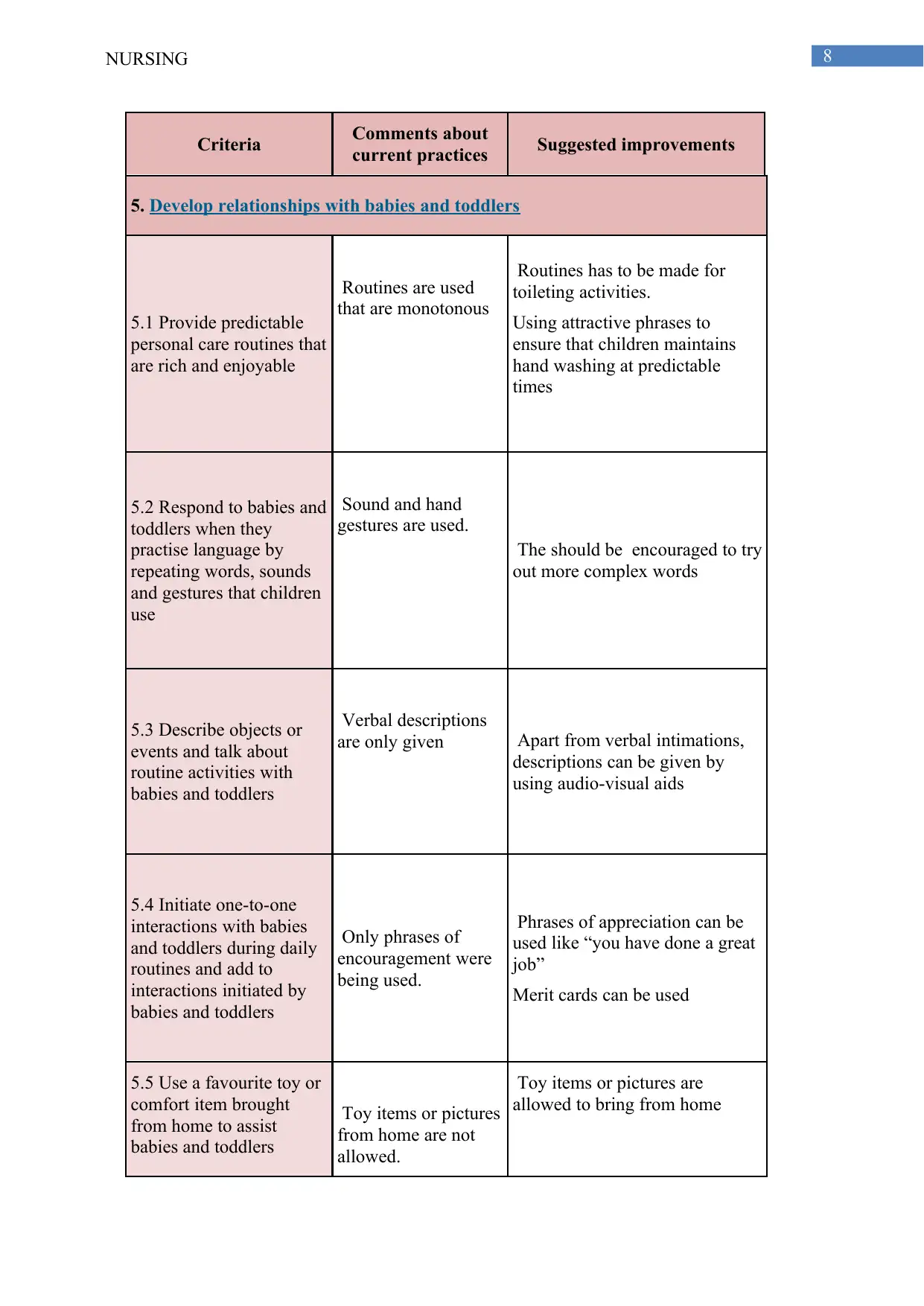
8NURSING
Criteria Comments about
current practices Suggested improvements
5. Develop relationships with babies and toddlers
5.1 Provide predictable
personal care routines that
are rich and enjoyable
Routines are used
that are monotonous
Routines has to be made for
toileting activities.
Using attractive phrases to
ensure that children maintains
hand washing at predictable
times
5.2 Respond to babies and
toddlers when they
practise language by
repeating words, sounds
and gestures that children
use
Sound and hand
gestures are used.
The should be encouraged to try
out more complex words
5.3 Describe objects or
events and talk about
routine activities with
babies and toddlers
Verbal descriptions
are only given Apart from verbal intimations,
descriptions can be given by
using audio-visual aids
5.4 Initiate one-to-one
interactions with babies
and toddlers during daily
routines and add to
interactions initiated by
babies and toddlers
Only phrases of
encouragement were
being used.
Phrases of appreciation can be
used like “you have done a great
job”
Merit cards can be used
5.5 Use a favourite toy or
comfort item brought
from home to assist
babies and toddlers
Toy items or pictures
from home are not
allowed.
Toy items or pictures are
allowed to bring from home
Criteria Comments about
current practices Suggested improvements
5. Develop relationships with babies and toddlers
5.1 Provide predictable
personal care routines that
are rich and enjoyable
Routines are used
that are monotonous
Routines has to be made for
toileting activities.
Using attractive phrases to
ensure that children maintains
hand washing at predictable
times
5.2 Respond to babies and
toddlers when they
practise language by
repeating words, sounds
and gestures that children
use
Sound and hand
gestures are used.
The should be encouraged to try
out more complex words
5.3 Describe objects or
events and talk about
routine activities with
babies and toddlers
Verbal descriptions
are only given Apart from verbal intimations,
descriptions can be given by
using audio-visual aids
5.4 Initiate one-to-one
interactions with babies
and toddlers during daily
routines and add to
interactions initiated by
babies and toddlers
Only phrases of
encouragement were
being used.
Phrases of appreciation can be
used like “you have done a great
job”
Merit cards can be used
5.5 Use a favourite toy or
comfort item brought
from home to assist
babies and toddlers
Toy items or pictures
from home are not
allowed.
Toy items or pictures are
allowed to bring from home
⊘ This is a preview!⊘
Do you want full access?
Subscribe today to unlock all pages.

Trusted by 1+ million students worldwide
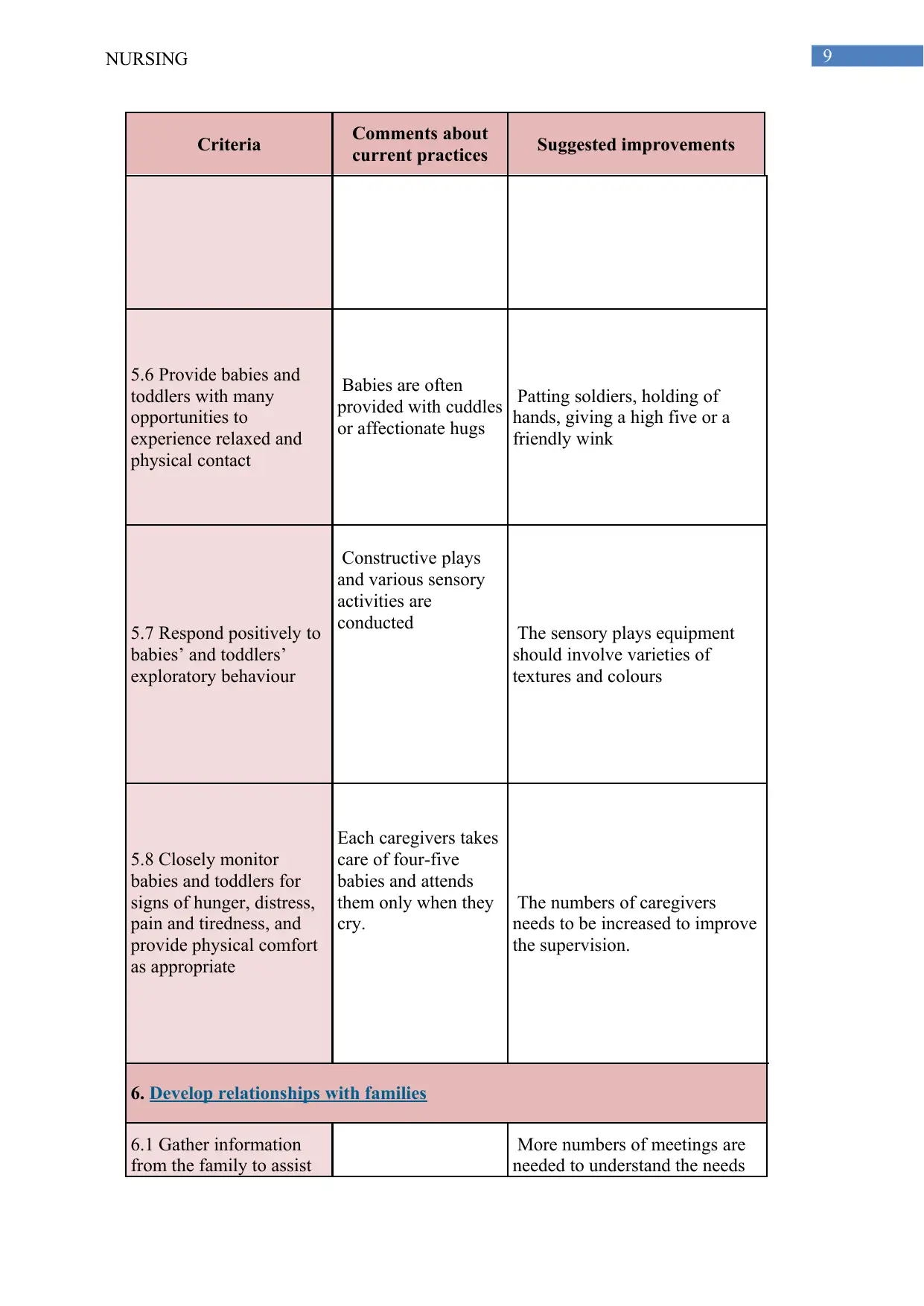
9NURSING
Criteria Comments about
current practices Suggested improvements
5.6 Provide babies and
toddlers with many
opportunities to
experience relaxed and
physical contact
Babies are often
provided with cuddles
or affectionate hugs
Patting soldiers, holding of
hands, giving a high five or a
friendly wink
5.7 Respond positively to
babies’ and toddlers’
exploratory behaviour
Constructive plays
and various sensory
activities are
conducted The sensory plays equipment
should involve varieties of
textures and colours
5.8 Closely monitor
babies and toddlers for
signs of hunger, distress,
pain and tiredness, and
provide physical comfort
as appropriate
Each caregivers takes
care of four-five
babies and attends
them only when they
cry.
The numbers of caregivers
needs to be increased to improve
the supervision.
6. Develop relationships with families
6.1 Gather information
from the family to assist
More numbers of meetings are
needed to understand the needs
Criteria Comments about
current practices Suggested improvements
5.6 Provide babies and
toddlers with many
opportunities to
experience relaxed and
physical contact
Babies are often
provided with cuddles
or affectionate hugs
Patting soldiers, holding of
hands, giving a high five or a
friendly wink
5.7 Respond positively to
babies’ and toddlers’
exploratory behaviour
Constructive plays
and various sensory
activities are
conducted The sensory plays equipment
should involve varieties of
textures and colours
5.8 Closely monitor
babies and toddlers for
signs of hunger, distress,
pain and tiredness, and
provide physical comfort
as appropriate
Each caregivers takes
care of four-five
babies and attends
them only when they
cry.
The numbers of caregivers
needs to be increased to improve
the supervision.
6. Develop relationships with families
6.1 Gather information
from the family to assist
More numbers of meetings are
needed to understand the needs
Paraphrase This Document
Need a fresh take? Get an instant paraphrase of this document with our AI Paraphraser
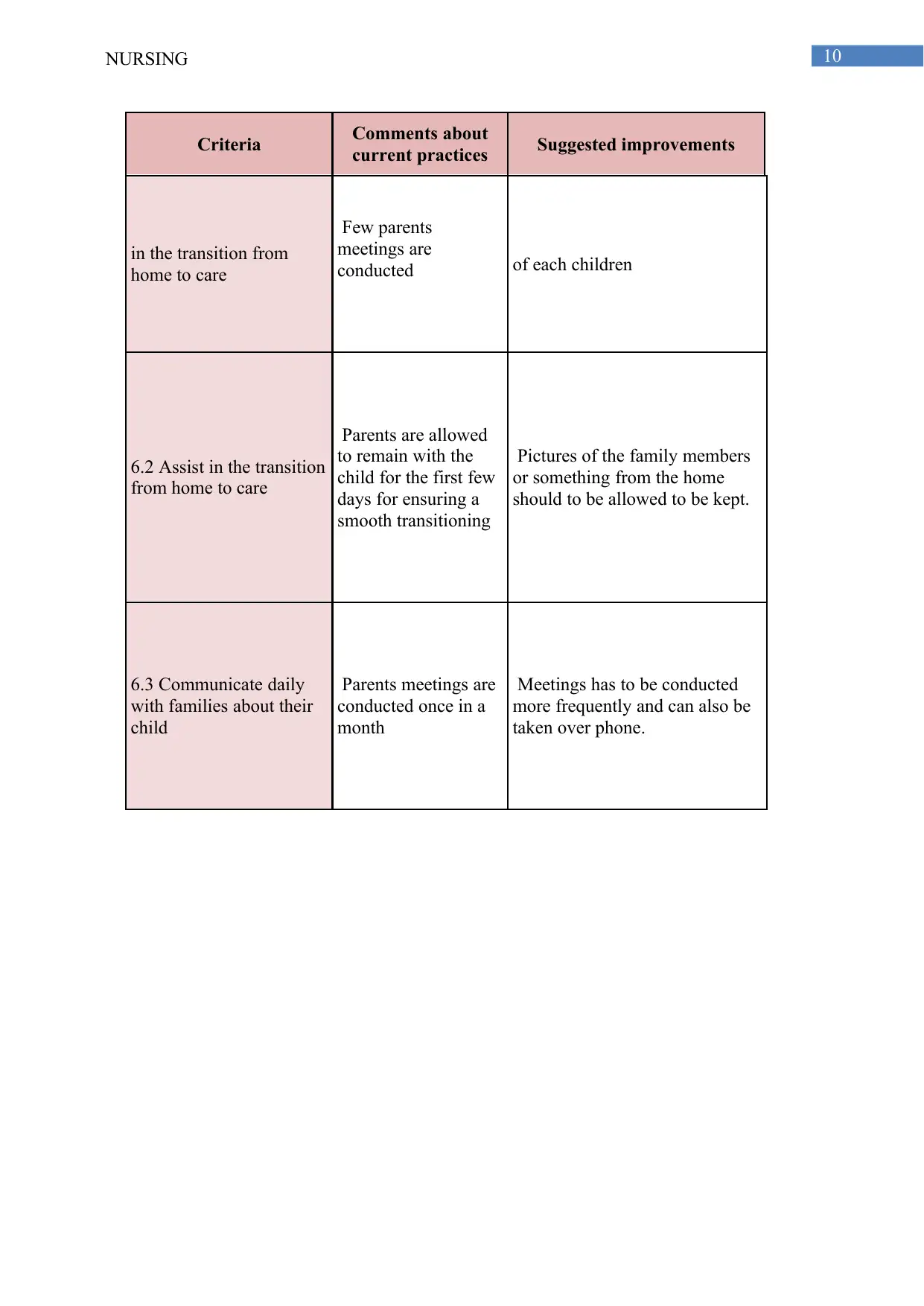
10NURSING
Criteria Comments about
current practices Suggested improvements
in the transition from
home to care
Few parents
meetings are
conducted of each children
6.2 Assist in the transition
from home to care
Parents are allowed
to remain with the
child for the first few
days for ensuring a
smooth transitioning
Pictures of the family members
or something from the home
should to be allowed to be kept.
6.3 Communicate daily
with families about their
child
Parents meetings are
conducted once in a
month
Meetings has to be conducted
more frequently and can also be
taken over phone.
Criteria Comments about
current practices Suggested improvements
in the transition from
home to care
Few parents
meetings are
conducted of each children
6.2 Assist in the transition
from home to care
Parents are allowed
to remain with the
child for the first few
days for ensuring a
smooth transitioning
Pictures of the family members
or something from the home
should to be allowed to be kept.
6.3 Communicate daily
with families about their
child
Parents meetings are
conducted once in a
month
Meetings has to be conducted
more frequently and can also be
taken over phone.
1 out of 11
Your All-in-One AI-Powered Toolkit for Academic Success.
+13062052269
info@desklib.com
Available 24*7 on WhatsApp / Email
![[object Object]](/_next/static/media/star-bottom.7253800d.svg)
Unlock your academic potential
Copyright © 2020–2025 A2Z Services. All Rights Reserved. Developed and managed by ZUCOL.


